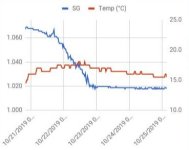PeeBee
Brewer
Hey you two, don't shoot the messenger! This is the "suggestions" forum, and the suggestion I was making relates to a relatively new concept that is gaining a lot of interest - now wouldn't it be nice if Beersmith kept up with that interest? If Beersmith doesn't, the next "new thing" will and I don't imagine Brad want's to let Beersmith fall by the wayside.
But I've been given instructions to petition Brad for what I think will be useful modifications; thanks very much for that.
I'm quite used to fudging programs to get what I want (but I wasn't even aware that Beersmith switches off when mash temperature gets over 71C - thanks again for that). I'm rather keen to try "Brew Bama's" idea of fudging a dummy ingredient so I can split an ingredient's potentially "fermentable" extract and "not fermentable" extract (particularly to help guesstimate extracts from 71C-plus mashes).
I'd still like mash predictions to extend beyond 71C, if only roughly (better than nothing at all). I'd still like "not fermentable" to be a percentage not an all-or-nothing checkbox option. But these changes are to gain some user tools, not demand Beersmith provides accurate estimates for extreme uses.
Along the way this thread has picked out that the modifications could be used for mainstream "alcoholic" brews ("Bombardier" like beers) not just my pet subject of "low-alcohol" beers. I might be tempted to experiment along those lines (I'm not a saint for most days of the week).
I'm impressed; I'm getting more than I bargained for out of just making a suggestion!
But I've been given instructions to petition Brad for what I think will be useful modifications; thanks very much for that.
I'm quite used to fudging programs to get what I want (but I wasn't even aware that Beersmith switches off when mash temperature gets over 71C - thanks again for that). I'm rather keen to try "Brew Bama's" idea of fudging a dummy ingredient so I can split an ingredient's potentially "fermentable" extract and "not fermentable" extract (particularly to help guesstimate extracts from 71C-plus mashes).
I'd still like mash predictions to extend beyond 71C, if only roughly (better than nothing at all). I'd still like "not fermentable" to be a percentage not an all-or-nothing checkbox option. But these changes are to gain some user tools, not demand Beersmith provides accurate estimates for extreme uses.
Along the way this thread has picked out that the modifications could be used for mainstream "alcoholic" brews ("Bombardier" like beers) not just my pet subject of "low-alcohol" beers. I might be tempted to experiment along those lines (I'm not a saint for most days of the week).
I'm impressed; I'm getting more than I bargained for out of just making a suggestion!

